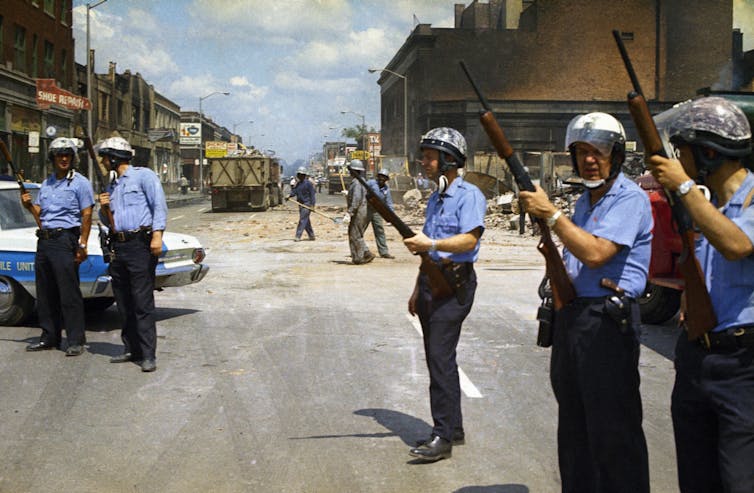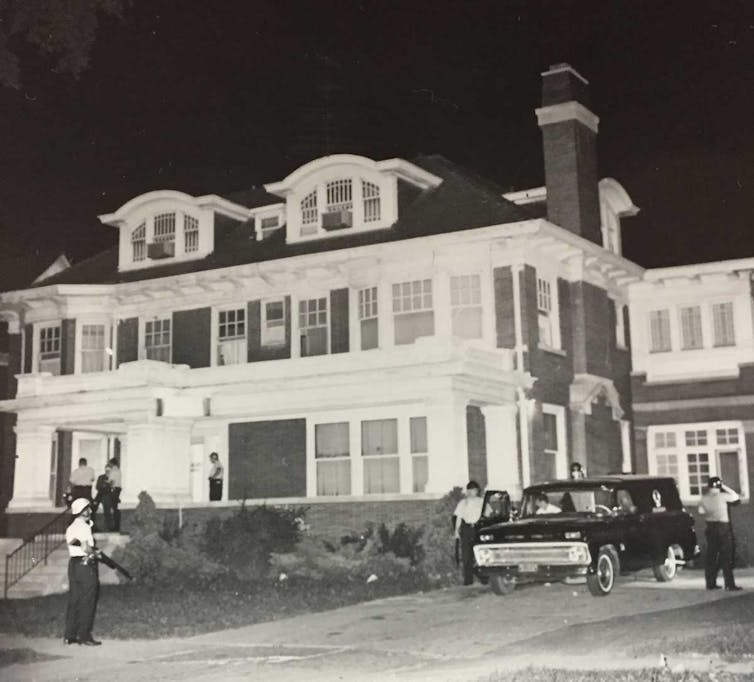Police killings of 3 black men left a mark on Detroit's history more than 50 years ago
- Written by Jeffrey Horner, Senior Lecturer of Urban Studies, Wayne State University
Police routinely used violent force against blacks in the U.S. before the 1940s[1], primarily as a means of preserving segregation in cities.
It became a last line of defense for segregationists after the U.S. Supreme Court in 1948[2] weakened the ability of property owners to refuse to sell to people of color. By the 1950s, with the decline of legalized segregation, many white community associations were organizing to “defend” their neighborhoods against black residents who were seeking housing there. By the 1960s, a squadron of Detroit police officers known as the Big Four[3] began patrols specifically aimed at maintaining racial homogeneity in the city’s white neighborhoods.
Albert Cobo, Detroit’s mayor from 1950 to 1957, openly campaigned in 1949 on a promise to prevent the “Negro invasion.[4]”
In Detroit in the late 1950s and early 1960s, federal urban redevelopment projects – under statutory authority of Slum Clearance and Urban Renewal[5] – displaced thousands of black residents and businesses in the largest black quarter of the city.
Districts known as Paradise Valley and Black Bottom[6] were converted into an interstate freeway and upper middle-class residential district, available to few who were displaced. Seemingly, blacks were no longer welcome even in black areas of the city.
Many relocated to the 12th Street commercial district, a Jewish quarter where many blacks held jobs, leading to residential overcrowding. This set the stage for the deadliest urban civil insurrection of the 1960s – the Detroit Rebellion of 1967[7]. It was sparked by a police bust of an after-hours drinking establishment frequented by blacks, but years of police brutality and deteriorating social conditions fueled the flame.
One incident in which white police officers killed three black men happened at the height of the insurrection.
I believe these events show that police brutality today, perpetrated disproportionately against blacks[8] in urban areas, is more of a continuation of historic patterns than a set of novel events.
1967 rebellion
 Police in the streets after the rioting in Detroit in July 1967.
AP Photo
Police in the streets after the rioting in Detroit in July 1967.
AP Photo
The Detroit Rebellion left 43 people dead and caused hundreds of documented and undocumented injuries. The vast majority of the 7,000 people who were arrested were black.
The primary cause of the unrest, according to the 1968 Report of the National Advisory Commission on Civil Disorders[9], was police brutality against blacks followed by unemployment, housing conditions, poor educational opportunities and many other public and social issues that disparately impacted black populations.
One of the most well-documented instances of police brutality in this time involved the deaths of three unarmed black men by white police. Pulitzer Prize-winning novelist John Hersey observed, in his definitive work, “The Algiers Motel Incident[10],” that the “episode contained all of the mythic themes of racial strife in the United States: the arm of the law taking the law into its own hands … the devastation in both black and white human lives that follows in the wake of violence as surely as a ruinous and indiscriminate flood after torrents.”
Hersey had initially set out to investigate and report on the causes of the entire uprising in Detroit. Upon on his arrival that August, his attention quickly focused on the incident at the Algiers Motel. His remarkable, exhaustive accounts detail the horrifying chain of events that were overshadowed by the Detroit Rebellion of 1967.
What happened at the Algiers Motel
 Algiers Manor Annex, July 26, 1967.
US Federal Bureau of Investigation/Wikimedia Commons[11]
Algiers Manor Annex, July 26, 1967.
US Federal Bureau of Investigation/Wikimedia Commons[11]
Hersey, writer Sidney Fine[12] and others[13] have noted that accounts of the events that led to the deaths of Carl Cooper, Aubrey Pollard and Fred Temple have often been conflicting.
But here are the basic facts.
In the early hours of July 26, 1967, Detroit police Officers Ronald August, Robert Paille and David Senak responded to a report of civilian snipers at the Algiers Motel, about 1 mile east of the center of the uprising.
According to eyewitness news accounts and subsequent investigations[14], officers began a room-to-room search for weapons and suspects once they arrived at the motel annex. Officers Paille and Senak then encountered Fred Temple, an 18-year-old employed by the Ford Motor Company. He was on the phone in an apartment room and the two officers fired on him simultaneously, killing him.
In the meantime, National Guardsmen and additional police had rounded up motel occupants in the lobby of the annex and were questioning and searching them. Rushing down the steps from the second floor and unwittingly entering the lobby was 17-year-old Carl Cooper. He was immediately shot dead, but not before declaring that he didn’t have a weapon. Another version of Cooper’s death suggests that it occurred earlier, at the time of the initial raid. No one was charged in his death.
Aubrey Pollard was killed in a separate set of interrogations, which Hersey wrote could be described as a “death game.” Individual suspects were moved into a separate apartment. There, officers discharged their gun into the floor to simulate an execution to frighten the suspects into talking. According to testimony from Officer August, a struggle ensued in the apartment over August’s shotgun, leaving Pollard dead.
No deadly arms were uncovered during the raid. According to eyewitness testimony, the report of snipers that prompted the raid was likely caused by a cap gun used to start races in track events. Witnesses said they saw Cooper firing a few rounds inside and outside of the annex in what one described as an act of mischief.
Aftermath
Officer August was charged with murder after extensive hearings and investigations. His defense counsel Norman Lippitt[15] argued that Hersey’s book, which was published only a year after the incident and received extensive news coverage, was “too inflammatory” to allow a fair trial with unprejudiced jurors.
The judge agreed and moved the trial to Mason, Michigan, a small county seat about 90 miles from Detroit, all but guaranteeing an all-white jury. After a six-week long trial, Officer August was acquitted.
A civil rights trial followed in Flint in 1970. Officers August, Paille and Senak were charged with conspiring to deny civil rights to the three victims plus eight others, resulting in an acquittal for all three officers.
The response to the Rebellion of Detroit’s electorate in the 1969 mayoral election was a victory for the law and order candidate, Roman Gribbs. His newly appointed chief of police, John Nichols, quickly implemented a novel policing procedure called Stop the Robberies, Enjoy Safe Streets[16]. A special unit of the Police Department employed police officers in civilian clothes to entrap criminals in crimes that wouldn’t have otherwise occurred. Such policing practices, and a growing black population, led to the 1973 election of Detroit’s first black mayor, Coleman A. Young.
I believe the Algiers Motel incident illustrates a consistent pattern of deadly police brutality perpetrated against blacks, caused primarily by predispositions to social control of blacks and other persons of color.
As legal methods of social control such as segregation policies were overturned by courts throughout the 20th century, enforcement of existing segregation patterns are increasingly taken on, consciously or unconsciously, by local police departments, often using violence and brutality.
Sadly, these patterns existed long before that fateful night in the Algiers, and continue into our present.
References
- ^ before the 1940s (books.google.com)
- ^ U.S. Supreme Court in 1948 (supreme.justia.com)
- ^ Big Four (books.google.com)
- ^ Negro invasion. (www.crainsdetroit.com)
- ^ Slum Clearance and Urban Renewal (www.gpo.gov)
- ^ Paradise Valley and Black Bottom (detroithistorical.org)
- ^ Detroit Rebellion of 1967 (www.wsupress.wayne.edu)
- ^ disproportionately against blacks (mappingpoliceviolence.org)
- ^ Report of the National Advisory Commission on Civil Disorders (babel.hathitrust.org)
- ^ The Algiers Motel Incident (books.google.com)
- ^ US Federal Bureau of Investigation/Wikimedia Commons (commons.wikimedia.org)
- ^ Sidney Fine (msupress.org)
- ^ others (solidarity-us.org)
- ^ eyewitness news accounts and subsequent investigations (jhupbooks.press.jhu.edu)
- ^ Norman Lippitt (www.crainsdetroit.com)
- ^ Stop the Robberies, Enjoy Safe Streets (detroithistorical.org)
Authors: Jeffrey Horner, Senior Lecturer of Urban Studies, Wayne State University

